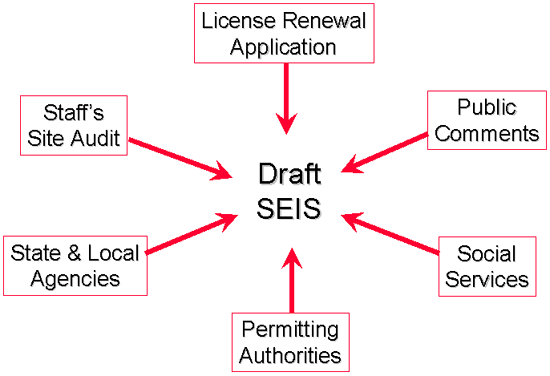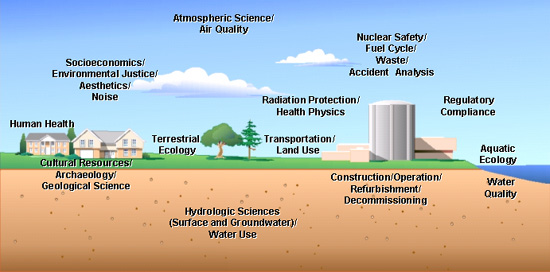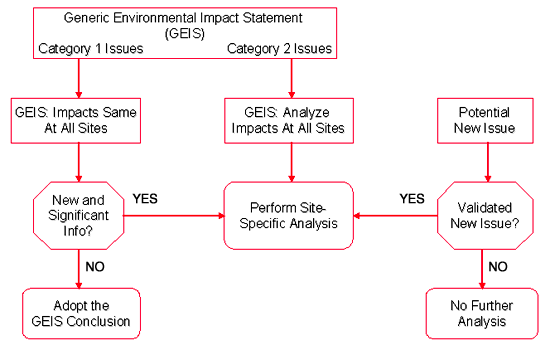Environmental Impact of Reactor License Renewal
The NRC has responsibilities under the National Environmental Policy Act (NEPA), which calls for a review of the environmental impact of reactor license renewal.
On this page:
- Contents of an Application
- Rules and Regulations (10 CFR Part 51)
- License Renewal Process
- Environmental Guidance
- Information Gathering
- Team Expertise
- Analysis Approach
- How Impacts Are Quantified
- GEIS Structural Attribute
- Application Process - Environmental Review
- Review Milestone
- Environmental Review
Contents of an Application
- Environmental Report Supplement (10 CFR 54.23)
- Submit supplement in compliance with 10 CFR Part 51, Subpart A
Rules and Regulations (10 CFR Part 51)
- National Environmental Policy Act (NEPA) requires Federal agencies to use a systematic approach to consider environmental impacts
- Atomic Enery Act
- Energy Reorganization Act
- National Environmental Policy Act
- Other Statutes
- Commission has determined that an environmental impact statement will be prepared for a license renewal action
License Renewal Process
- Application Received - Month 0
- Notice of Intent - Month 3
- Scoping Meeting - Month 4
- Environmental Review Site Audit - Month 4
- Requests for Additional Information (RAI) - Month 6
- Draft Supplement Environmental Impact Statement (SEIS) - Month 11
- Final SEIS - Month 19
For additional information, see License Renewal Process.
Environmental Guidance
- USNRC Regulatory Guides 4.2 (NUREG-0099), Content of Environmental Reports, and Reactor Site Criteria 4.7
- NUREG-1555, Environmental Standard Review Plan
- Volumes 1 and 2 for CP, ESP, OL, and COL
- Supplement 1 for license renewal
Information Gathering
The following diagram shows how a Draft Supplement Environmental Impact Statement is derived.

Team Expertise
For the review, the Environmental PM or EPM establishes a team made up of the NRC staff, supplemented by experts in various fields from labs like Pacific Northwest National Laboratory.

Analysis Approach

For additional information, see Detail Analysis Approach.
How Impacts Are Quantified
NRC-defined impact levels that are consistent with the Council on Environmental Quality guidance for NEPA analysis:
- Small: Effect is not detectable or too small to destabilize or noticeably alter any important attribute of the resource
- Moderate: Effect is sufficient to alter noticeably, but not destabilize, important attributes of the resource
- Large: Effect is clearly noticeable and sufficient to destabilize important attributes of the resource
GEIS Structural Attribute
Categorization of Issues
- Category 1 criteria:
- Impacts apply to all plants or, for some issues, to plants having a specific type of cooling system or other specified plant or site characteristic
- Single significance level (i.e., small, moderate or large) assigned to the impacts with two exceptions (certain fuel cycle impacts)
- Additional plant-specific mitigation measures not likely to be sufficiently beneficial to warrant implementation
- Category 2 criteria:
- One or more Cat-1 criteria cannot be met
Ninety-two issues considered for refurbishment and renewal
- 69 Category 1 Issues - NRC Generically Resolved
- 21 Category 2 Issues - Addressed in Application
- Two Uncategorized Issues - Addressed by NRC
Detailed List: 92 issues in GEIS
Application Process - Environmental Review
- Environmental Report (ER) submitted with application
- Cat-1 Issues: Applicant not required to include analysis of impacts nor required to consider mitigation
- Cat-2 Issues: Applicant required to include analysis and required to consider mitigation alternatives
- Applicant required to include any known new and significant information on Cat-1 environmental impact issues to ensure Cat-1 conclusions are valid for current application
Postulated Accidents
- Design-Basis Accidents
- Severe Accidents
- Severe Accidents Mitigation Alternatives (SAMAs)
For additional information, see SAMA Evaluation Process.
Review Milestone
- Scoping and Comment Period
- Issue draft Supplement Environmental Impact Statement (SEIS)
- Issue final SEIS
For additional information, see Review Milestone.
Environmental Review
Take the Review.
Page Last Reviewed/Updated Tuesday, March 10, 2020
Page Last Reviewed/Updated Tuesday, March 10, 2020

